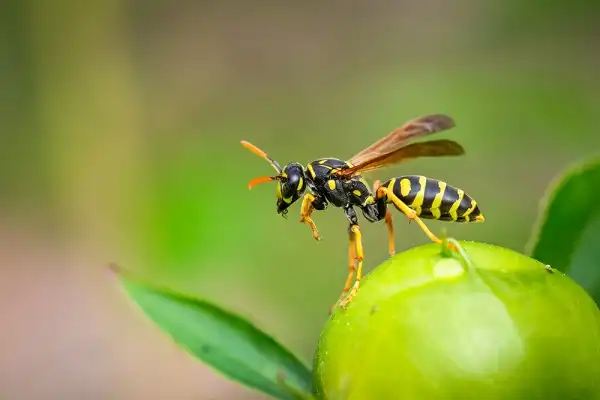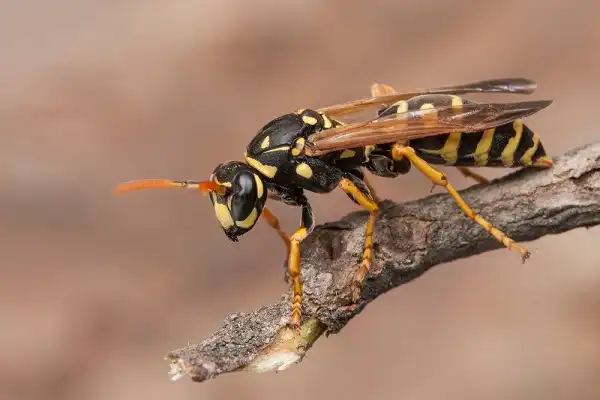Have you noticed more wasps buzzing around lately? Wasps, a unique and beneficial subset of the insect kingdom, are making their presence known as summer temperatures rise. While many people associate them with stings and nests full of aggressive paper-like creatures – there is much more to learn about wasps. In this blog post, we’ll explore some common types of wasps and why they can be important contributors within an ecosystem. Plus, we’ll talk about how to safely coexist with these remarkable insects! Let’s dive in and see what all the buzz is about!

Wasp Description
Wasps are a group of insects belonging to the order Hymenoptera and suborder Apocrita, which also includes ants and bees. There are over 30,000 identified species of wasps. They come in a variety of colors, from the familiar black and yellow stripes to green, red, and even blue. Despite their valuable contributions to the environment, wasps can be a nuisance and even dangerous to humans. They are known for their painful stings, which can cause an allergic reaction in some people. Additionally, wasps can become aggressive when their nests are disturbed, which can pose a threat to those in the vicinity. Overall, wasps are a fascinating and important part of many ecosystems. By understanding their role and behavior, we can learn to appreciate these remarkable insects and coexist with them safely.
Wasp Habitat
Wasp habitats vary depending on the species, but they can be found in almost any environment around the world, with the exception of the polar regions. Some wasps prefer to live in the ground, where they dig tunnels to create their nests. Others build their nests in trees, bushes, or other above-ground locations. Some wasps are even known to build their nests inside homes or other man-made structures. The materials used to build wasp nests also vary depending on the species. Paper wasps, for example, create their nests out of wood fibers, which they collect by chewing wood or other plant material. Mud daubers, on the other hand, use mud to build their nests, while hornets use a mixture of wood fibers and saliva to create their distinctive football-shaped nests. When choosing a location for their nests, wasps consider a variety of factors, including the availability of food, protection from predators, and access to water. The size and shape of the nest also depend on the species, with some nests housing just a few wasps and others containing thousands of individuals.
Wasp Diet
Wasps primarily feed on other insects, such as caterpillars, flies, and aphids. They also eat nectar and honeydew from plants. Some species of wasps are predatory, meaning they actively hunt their prey, while others are scavengers that feed on dead or decaying matter. Wasps also collect food for their larvae in the form of live or dead pests, as well as sugary liquids, such as nectar and honeydew. The female wasp will carry these back to her nest to feed her young. Adult wasps often participate in social behavior by sharing food among the members of their colony. To help prevent wasps from becoming a nuisance, it is recommended that any open containers of sugary liquids (such as soda cans) be covered when outside as they can attract wasps in search of food. Additionally, sweet scents such as perfumes and colognes should be avoided when outdoors as these too can attract unwanted guests. Finally, it is important to respect the natural habitats of these insects so that we can coexist peacefully with them in our environment.

Wasp Size
Wasps come in a variety of shapes and sizes, with some species reaching just a few millimeters in length while others can grow up to 2 inches long. In general, wasps are slender insects with four wings (two small forewings and two large hind wings) and an elongated body. Depending on the species, they may be black or brown in color, with yellow or orange markings. Wasps also have three distinct body segments: the head, thorax, and abdomen. The head is rounded with two antennae and four eyes (two compound eyes and two simple eyes). The thorax consists of three pairs of legs that aid in movement as well as two sets of wings for flight. Finally, the abdomen is where the wasp’s internal organs, such as its digestive and reproductive systems, are located.
Wasp Lifespan
The lifespan of a wasp depends on the species, with some living for only a few days while others can live up to several months. Female wasps typically have longer lifespans than males, and queens may live up to one year. In addition to their natural predators, wasps are also vulnerable to human activities such as habitat destruction and pesticide use. As such, it is important that we work towards preserving their habitats in order to ensure that these beneficial insects can continue to thrive in our environment. Overall, wasps play an integral role in maintaining the balance of many ecosystems around the world. By understanding and respecting these fascinating creatures, we can coexist with them safely and appreciate their importance in our environment.
Wasp Behavior
Wasps are highly social insects that form colonies and communicate with one another using chemical signals. They may build nests in sheltered areas such as under rocks or inside tree cavities, and in some species, these nests can be quite elaborate, consisting of multiple chambers for raising larvae. Wasps also have a variety of behaviors associated with food gathering and nesting. For example, female wasps will often hunt for live prey to feed their young, while males may gather materials such as plant fibers to construct the nest. Wasps may also engage in aggressive behavior if they feel threatened or perceive a threat to their colony or nest. Finally, wasps participate in social interactions within their colonies by sharing food among members or providing assistance to workers constructing the nest. By understanding and respecting wasp behavior, we can coexist peacefully with these important insects in our environment!
Wasps and Humans
Although wasps play an important role in many ecosystems, they can be a nuisance to humans when they come into contact with us or invade our homes. Wasps have venom which can cause painful stings and allergic reactions in some people, so it is important to use caution around them. There are several steps that you can take to prevent wasp infestations on your property such as removing sources of food (such as sugary drinks or pet food) that may attract them and sealing any potential entry points for nests.
Wasp Speed
Wasps are surprisingly fast flyers, capable of reaching speeds up to 25 miles per hour. This speed allows them to quickly and efficiently hunt down prey, carry food back to their nests, and defend themselves from predators. Wasps also have a surprisingly quick reaction time when avoiding obstacles or predators. Their reflexes are so fast that they can dodge objects in mid-air! This helps them to stay safe while traveling at high speeds through their environment. Overall, wasps possess impressive flying abilities that allow them to maintain their place in many ecosystems around the world. By understanding and respecting these remarkable creatures, we can continue to coexist with them safely in our environment.

Wasp Hunting
Wasps are adept hunters and can hunt both insects and other small animals. They use their powerful venom to paralyze prey, making it easier to transport back to their nests. Wasps will often search the ground for food or hunt in trees, bushes, and other vegetation. When a wasp finds prey, it will sting the animal multiple times in order to paralyze it before transporting it back to its nest. Wasps are also capable of storing food for later consumption or sharing amongst members of their colony. By understanding and respecting wasp hunting behaviors, we can coexist with them safely without causing any harm!
Wasps Life Cycle
The life cycle of a wasp begins as an egg laid by a queen. The eggs will then hatch into larvae, which are fed by the queen until they reach maturity. At this point, the larvae will become pupae and enter a resting stage before finally emerging as an adult wasp. Adult wasps have three main tasks: to hunt for food, build nests, and reproduce. Wasps can live anywhere from a few weeks to several months depending on the species and environment. By understanding and respecting the life cycle of wasps, we can coexist safely with them in our environment!
Wasp Natural Repellents
While wasps play an important role in our ecosystem, they can also be a nuisance to human populations. For those who wish to avoid using chemical insecticides, there are several natural repellents that can be effective in keeping wasps at bay. One such repellent is peppermint oil. Wasps have a strong sense of smell and find the scent of peppermint overwhelming, making it a great natural repellent. Simply mix a few drops of peppermint oil with water and spray the solution around areas where wasps are known to gather. This will help to deter them from entering your home or outdoor living space. Another natural repellent that has been known to work well is white vinegar. Wasps are repelled by acidic scents, and white vinegar is a great source of acid. Simply mix equal parts water and white vinegar and fill a spray bottle with the solution. Spray this solution around areas where wasps are known to gather, such as around outdoor dining areas or near trash cans. It’s important to note that natural repellents may not be as effective as chemical insecticides, and they may need to be reapplied more frequently. Additionally, some natural repellents may not be safe to use around pets or small children. It’s important to read the labels carefully and take appropriate precautions before using any natural repellents.
Wasps Nests
Wasps are social insects that form colonies typically consisting of workers, drones, and a single reproductive queen. These colonies work together to build nests which serve as homes for the wasps. Wasps typically build nests out of a combination of mud, wood fibers, and saliva which they then coat with a waxy protective layer. They construct these nests in sheltered areas such as tree branches, eaves, or even human dwellings. By understanding and respecting wasp nesting behaviors we can coexist with them safely!

Conclusion
Wasps are fascinating creatures that play an important role in many ecosystems around the world. By understanding and respecting wasp behavior, we can coexist safely with these remarkable insects in our environment! Wasps help to maintain balance by preying on other insects, pollinating flowers, and constructing nests for their young. We should appreciate their importance and learn to peacefully coexist with them in our environment. Thank you for taking the time to learn about wasps today!
Frequently Asked Question

